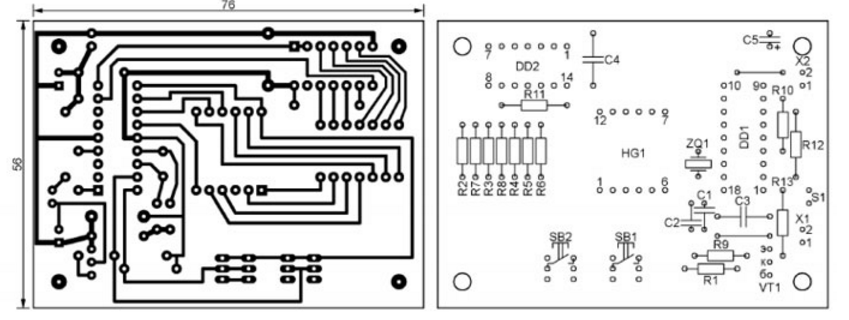
|
|
ENCYCLOPEDIA OF RADIO ELECTRONICS AND ELECTRICAL ENGINEERING Generator for testing car tachometers. Encyclopedia of radio electronics and electrical engineering
Encyclopedia of radio electronics and electrical engineering / Automobile. Speedometers and tachometers This generator was designed for testing and adjusting tachometers and other devices that require a signal from the crankshaft speed sensor of a car engine to operate.
The generator circuit is shown in Fig. 1. It uses a PIC16F628A-I/P (DD1) microcontroller. The pulses generated at output RA2 are sent through an amplifier on transistor VT1 to the output connector X1. By using jumper S1, load resistor R12 can be connected to the collector circuit of the transistor. When the jumper is removed, the commutator load must be in the device being tested. The simulated crankshaft speed can take 28 fixed values from 500 to 2500 min-1 (in 100 min-1 steps) and up to 6000 min-1 (in 500 min-1 steps), displayed on the HG1 LED indicator. They move from one fixed value to another by pressing the SB1 button (in the direction of increasing the frequency) or SB2 (in the direction of decreasing it). A zero frequency value is also provided, at which there are no output pulses. In all other cases, for each crankshaft revolution, two output pulses of positive polarity with a duration of 100 μs are generated. The root mean square error of frequency setting is 0,4%. The duration of pauses between generated pulses is counted based on interrupt requests generated when the TMR2 timer overflows. The interrupt processing procedure generates output pulses after each count of the number of requests corresponding to the repetition period of these pulses at the selected rotation speed. Periodically, the program checks the state of the buttons and, having detected a pressed one, changes the values of the variables that set the frequency of the generated pulses, and also displays the value of the simulated crankshaft rotation speed on the HG1 LED indicator with common cathodes of the elements of each of the four digits. The display is built on a dynamic principle. The program generates serial codes for controlling the anodes of the indicator elements at the RB3 output of the microcontroller. Using clock pulses coming from the output of RB2, these codes are loaded into the shift register DD2 and then converted into parallel form, they are sent to the anode pins of the indicator. The indicator digits are turned on one by one by pulses arriving at their common cathodes from the outputs RB4-RB7 of the microcontroller.
All parts of the generator are mounted on a single-sided printed circuit board made of foil fiberglass with dimensions of 76x56 mm, the drawing of which is shown in Fig. 2. The board is designed for installation of permanent MLT-0,125 resistors. Capacitors C1, C2 - K10-17 or other ceramic, C3, C4 - film K73-17, oxide capacitor C5 - K50-35 or imported. Panels are installed on the board for the DD1, DD2 chips and the HG1 indicator. The generator printed circuit board file in Sprint Layout 5.0 format and the microcontroller program can be downloaded from ftp://ftp.radio.ru/pub/2013/09/gener.zip. Author: V. Kiba
Artificial leather for touch emulation
15.04.2024 Petgugu Global cat litter
15.04.2024 The attractiveness of caring men
14.04.2024
▪ Holes in the light tied in knots ▪ PHILIPS offers its own system for protecting distributed multimedia content ▪ A new type of infrared polaritons ▪ Miniature neural networks of the brain are grown
▪ section of the site Personal transport: land, water, air. Article selection ▪ article Truly Russian Beginnings. Popular expression ▪ article Can oysters live out of water? Detailed answer ▪ article Picker of goods. Standard instruction on labor protection ▪ article Block of electronic ignition. Encyclopedia of radio electronics and electrical engineering ▪ article Outwitting inertia. physical experiment
Comments on the article: Talyan Doesn't work, at least not on auto. We need a 12 volt rectangular pulse, and here 5 volts.
Home page | Library | Articles | Website map | Site Reviews www.diagram.com.ua |






 Arabic
Arabic Bengali
Bengali Chinese
Chinese English
English French
French German
German Hebrew
Hebrew Hindi
Hindi Italian
Italian Japanese
Japanese Korean
Korean Malay
Malay Polish
Polish Portuguese
Portuguese Spanish
Spanish Turkish
Turkish Ukrainian
Ukrainian Vietnamese
Vietnamese


 Leave your comment on this article:
Leave your comment on this article: